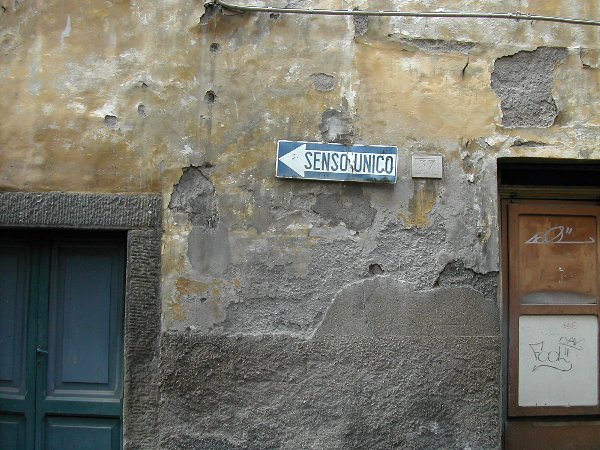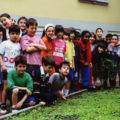Taken during the Imaging in Italy course.
Travelling India in Luxury… and Out
In 1998, I visited India twice. The first trip, around May I think, was to fulfill a promise made in 1996 to Woodstock School, that when they got Internet access I would come and help train the staff in using the Internet. Which I did, and it was both fun and funny, but that’s another story.
The second trip was almost accidental. I was at the Adaptec offices in California, on one of my usual summer visits, when the subject of the HP Asia trip came up in a staff meeting. Hewlett-Packard planned a six-week trip of Asia, Australia, and New Zealand, a marketing road show for resellers and distributors throughout the area. They wanted someone from Adaptec along to talk about our software, which was bundled with their CD recorders. No one wanted to do the entire trip, so we discussed how to divvy it up. There were immediate volunteers for Australia/NZ and east Asia. India was also on the itinerary.
“I’m probably the only one who has all the shots for India,” I said.
“Shots?!?”
There were no other takers, so India was mine.
The first half of the trip I spent in the lap of luxury. In Delhi I stayed on the Executive floor of the Taj Mahal hotel, one of the world’s finest. With HP’s corporate discount it wasn’t, by US corporate standards, even terribly expensive (about $175 a night) and I wasn’t paying for it, anyway. The service was the best I’ve had at any hotel, ever: competent, efficient, and always there, without being intrusive. Internet access from anywhere in India wasn’t great in those days, so downloading dozens of email messages per day was quite a chore, but, with the help of a very smart hotel technician, we eventually got it done. She was startled when I told her how valuable her skills were, but I’m sure that by now she has figured it out.
From Delhi I flew to Mumbai (Bombay), then Chennai (Madras). I was one of three or four speakers at each stop. The others had prepared PowerPoint presentations about various aspects of HP technology; I did off-the-cuff demonstrations of our CD recording software. The audiences seemed to enjoy my ad-libbing more than the canned presentations, even though those included lots of multimedia bells and whistles.
While drinking tea after the presentations, I would chat with the resellers and distis. One man kindly asked if this was my first visit to India, did I intend to visit the Taj Mahal etc. etc. I explained my long history with India, including four years at Woodstock School, a study abroad year, and a degree in Asian Studies and languages. “You’re more Indian than I am!” he exclaimed. A women in Delhi told me that her own kids didn’t speak Hindi fluently; they spoke English at home and school, were studying French as a second language, and only spoke Hindi with the servants, “So they speak it very badly.”
From Chennai I flew back to Delhi, then took the train and a taxi up to Mussoorie for a visit to Woodstock. From the lap of luxury to the lap of… well, not luxury. I traded my snappy business suit and heels for jeans and hiking boots. It was unseasonably raining most of the time I was there, and I was staying with friends at the top of the hill, so by the time I got home from school each evening I was soaked to the knees (sometimes higher), and the air was too damp for anything to dry just by hanging. (Clothes dryer? Are you kidding?) I put my jeans on top of the woodburning stove to dry, and accidentally scorched them.
When my week was up, I took a taxi back down the hill to catch my train. It was raining harder than ever. We drove over a few minor landslides, and probably just missed getting stuck behind a major one. As we bumped along, I amused myself pondering the contrasts of my two weeks in India, and the amazing contradictions and contrasts you can see every day, anyplace, in that country.
Scuola Guida: Learning to Drive in Italy
One side effect of living in Lecco is that I need to drive. Not so much to get around Lecco itself, nor even into Milan, but because our fourth family member, Hamish the horse, now lives in a place not easily reached by public transport. (Yes, there are buses, but they don’t run very often.) So it’s time to get an Italian driving license; the grace period for driving on my American one expired about 12 years ago.
Unfortunately, American licenses are not directly convertible to Italian; you have to go through the same process as an Italian first-time driver. This is far more difficult and longer than getting a license in the United States; I think that’s a good thing, given the challenges of driving in Italy.
The first step to getting a license is to pay three different fees (a total of 33 euros), and have a medical exam of sorts, mostly about vision. That plus filling out some forms gets you a foglio rosa (pink sheet) – a learner’s permit. I am doing all this through a driving school, which is costly, but makes things somewhat easier: they take care of the paperwork and standing in line for you.
Then you have to pass a written “theory” test. It’s only 30 true-or-false questions (three each on 10 topics), but if you miss more than four, you have to wait a month and a day before you can try again, and the test is harder than it looks: it demands a thorough understanding of Italian legal/bureaucratic language, at least as relates to driving. Immigrants not fluent in Italian have the option to take a much easier oral test; I could probably have gotten away with claiming this, but the oral would have taken longer to schedule, so I opted for the written.
The driving school offers theory lessons three times a week. I went to two of these, but found them excruciatingly dull. It’s no doubt great for beginners and non-fluent immigrants to have everything explained six times over, but I find it hard enough to sit through any class for 90 minutes, let alone “Road Signs for Dummies”. The only interesting part was the teacher’s endless stock of horrible stories about drivers who became distracted and “ci ha lasciato la pelle” (literally, “he left his skin,” meaning “he died”). According to the teacher, the major cause of road accidents is: “Dis- dis- …?” (prompting for the word). “Disregard for the rules?” I was tempted to offer, but I kept my mouth shut; I’d already seen that he didn’t understand my sense of humor. The answer he was looking for was “Disattention,” which I suffered in his class more than I ever have on the road.
Fortunately, the classes were not required, and I already had another source of help on Italian driving theory. Cristina, a member of the Expats in Italy online group I frequent, has a very helpful website about driving in Italy, which in turn links to WebPatente, a useful program for learning the theory and practicing for the exam, complete with audio commentary on your results.
The questions asked in the practice exams are presumably based on real exams past and present. The funniest one I ran across in my hours of practice was: “True or False: Distraction and a reduced sense of danger can be caused by… excessively spiced foods.”
This is almost as funny as the question my dad had to answer in a driving test in Indonesia, years ago:
You’re driving down the road and you see a Stop sign. You should:
a. Stop
b. Slow down.
c. Look to see if a policeman is watching.
Meanwhile, back in Italy… I had to argue with Mr. Realini, the owner of the driving school, to convince him that I could prepare myself for the exam without the help of their classes or preparatory quizzes. (NB: My attending or not made no difference to the amount of money they’re getting out of me: a flat fee of 500 euros, plus however many driving lessons at 23 euros each) But, after a couple of nasty head-on collisions with me, he agreed to schedule it for September 22nd.
So I turned up at the school at 10:45 Monday morning. Then had a last-minute panic, because I suddenly realized that the foglio rosa was required for entrance to the exam, and it had vanished from my wallet. I ran home to search (I had time because the earlier exam sessions were running late), but couldn’t find it. Mr. Realini was nice about it (“Happens all the time”), and said we should just go to the exam anyway and see if they would let me in. So myself and four 18-year-olds trooped across the street to the Motorizzazione Civile (“Civil Motoring”? not a very accurate description, in Italy), where two dozen other candidates were waiting, with the owners of their respective driving schools. Mr. Realini, perhaps to distract me, asked what I thought of George Bush, so we had a lively discussion about that. The teenagers were amused, but shy to join in.
Around 12:15 we were finally allowed into the exam room. Our names were called off a computer printout, and each of us had to stand in front of the two examiners while our packet of papers and photo ID were scrutinized. They waved away my lack of a foglio rosa, but wanted to see my permesso di soggiorno (permission to stay in Italy), which I hadn’t known I was supposed to have with me. But at least I knew exactly where that was. I started to call Enrico to bring it (he’d already spent an hour searching for the foglio rosa), but then they decided that I only needed it for the actual driving test.
When all the candidates had been checked in, the examiners asked two people to come up and witness (with signatures) that the exam packets were still sealed. They then opened the packets, and one of them signed each exam sheet before tucking one into each student’s portfolio of papers. Then he called us up one by one to collect our packets. Finally, when all were seated with our papers in front of us, we were allowed to take the sheets out and start the exam.
Almost immediately, a vociferous argument started in the main office outside. I giggled. The examiner smiled ruefully and closed the doors, but you could still hear everything. Finally he poked his head out the door and asked if they could carry on after the exam. A minute later, someone poked his head in to apologize. “Just for this, you all pass,” he joked.
Of course, the first topic on the exam was something that had not come up in the driving school handbook nor WebPatente, about directional signage for roundabouts (which have only recently become popular in Italy). The wording on one of the three questions looked like it might be one of those linguistic traps: is a road coming off a roundabout called a traversa (cross-street), or is there some arcane technical term that I hadn’t heard before? After some pondering, and going on to do most of the other questions, I marked it “false.” You can’t make corrections on this test, so you have to be sure of the answer when you make your mark!
The rest of the test I felt pretty comfortable about, except the questions about the round blue sign with a human figure walking. I was mostly, but not entirely, sure that that meant “pedestrian area,” and answered the questions accordingly.
There was also a question on precedenza (right of way), my favorite subject – just because the rules are so charmingly contrary to actual behavior. The tests use some wildly theoretical intersections, with five or six streets meeting. The situations are all plausible enough, but the correct answers are not. One that sticks in my mind shows a four-lane street with a tram (on tracks) in the middle, flanked by a truck going the same direction. There are cars waiting to cross from each side of a smaller cross-street. Theoretically, the tram goes first, because any vehicle on tracks always has right of way. After that, the car with no traffic to its right should go, then the other car, and the truck last. Yeah, right – try to convince me that, in real life, the truck isn’t going to move at the same time the tram does, or even before! The book does reiterate that, no matter what the rule of precedenza says in any given situation, you should make sure that the other drivers agree with you before you move.
The test sheet was printed in black and white, including the illustrations, but there were two colored brochures of road signs and street diagrams that you could consult for clarity (each picture used in the test is numbered; the images in the brochures have matching numbers). I realized after I had handed in my test that a careful look through the whole brochure would have resolved the pedestrian zone question for me: the sign was there, by itself, just as shown on the test, but there was also another version of it as part of a larger sign with “zona pedonale” clearly printed!
We had 30 minutes to complete the test, but no one took that long. By around 20 minutes, the last test had been handed in, and we proceeded to corrections. Again each person’s name was called, and we had to stand in front of the examiners while they checked the test against the marking sheet, and called out the number of errors with “idoneo” or “non idoneo” (suitable or un-). Only two people failed, one with five errors, one with “many.” I only had one error, on that question about the roundabout, which turned out not to have been a trick after all. So I am suitable for driving – at least in theory.
When told my result, I did the American fist-pump gesture and shouted “Yes!” The other examinees all laughed; one of the examiners said disapprovingly (in Italian): “You’re in Italy now, say Si’.”
October 6, 2003
My classmate Yuti responded:
“This reminds me of my driving test in Bombay in 1981 when I turned 18. The test is supposed consist of an oral test and a test drive. There is a fat rule book, but I was told by my driving instructor that examiners ask only one of three rules, so I was to remember only these, and not bother with the rest. I don’t remember the rules verbatim but they go something like this: (1) you cannot have someone sitting on the car bonnet while the car is in motion, (2) you cannot have more than three persons in the front (in those days cars did not have bucket seats, but one long seat like the back), and (3) you cannot drive without headlights at night. These rules had numbers, like Rule 356, 452, etc.
The examiner would ask “Recite Rule so-and-so”, and you were expected to recite the rule verbatim as per the Rule book. Sure enough, my examiner asked me to recite the rule about sitting on the bonnet. That was the extent of my oral test.
For my test drive, I was asked to reverse park between two cars, and indicate turning left and right. In those days, Indian cars did not have turn indicators, so you had to use your hands. To turn right, you stuck your hand out of the window and made a circular motion with your wrist in a clock-wise direction. To indicate a left turn, you turned your wrist anti-clockwise. It took me 10 minutes to pass both tests. I got my license within a week by bribing the examiner Rs.50 (a hefty bribe in 1981), otherwise I would have waited months for it. But I was in a hurry to hit the road.
Now you know why Indians drive the way they do!”
Benares: The Distilled Essence of India
I spent the academic year 1985-86 in Benares, India’s holy city on the Ganges, on the University of Wisconsin’s study abroad program. I was the only one of the group of twelve students who had previously been to India, but I was wrong in thinking that that prepared me for Benares. Benares is the concentrated essence of India: teeming, filthy, intense. I was overwhelmed, and to this day I’m a bit surprised that I survived it; I used to run away to Allahabad to visit friends, drink Scotch, and watch videos.
Yet there was great beauty in Benares, beyond the standard boat trips on the Ganges and views of the temples and ghats.
One of our first evenings in Benares, some teammates and I decided to explore. We got lost almost immediately, and were a bit frightened, as well as beseiged by hawkers wanting us to look at this and that shop of tourist goods (they didn’t know we were poor students). We decided to go into a silk shop, to get everyone else off our backs for a while. This was the ground floor of a home made of whitewashed concrete, with wooden double doors and window frames painted blue or green. We took off our shoes and were ushered into the sales area, where the floor was completely covered by a white mattress, with white pillows to lean on. We were given hot, sweet, milky tea. Then the lights went out – one of Benares’ numerous power cuts. But kerosene lanterns were brought, and by their flaring golden light the shopkeeper began displaying his wares.
Benares is famous for its silks, richly colored and brocaded, with gold or silver borders. He flung out silk scarves so that they exploded into our laps like a fireworks display: magenta, scarlet, royal blue, parrot green – color after color, pattern after pattern. Scarves of all different sizes, then cushion covers and shawls. Had we been Indian women, we would have seen saris as well, or probably first. (Towards the end of my stay I did buy a Banarsi silk sari, to wear to a friend’s wedding; it took weeks to track down exactly the right shade of peacock blue, with a silver and black border. I only wore it the once, but I still have it.)
We didn’t buy anything that night, but the shopkeeper didn’t seem to mind, nor to feel that he’d wasted tea on us. We praised his silks as extravagantly as they deserved, and thanked him profusely, and he was very kind. Eventually we got away and found our way home. After that, I wasn’t so nervous about exploring Benares. People were usually pleasant; it helped that I spoke Hindi fluently.
I loved the gallis: the old, narrow, twisty streets, where the considerable flow of human, bicycle, and scooter traffic could be stopped dead by a cow suddenly deciding to have a lie-down. A galli is only about as wide as your outstretched arms can reach, but it’s as crowded as 5th Avenue, and similarly lined with shops. Except that these shops are reached by climbing up a few wooden steps, so that when you’re in the shop you look out and slightly down onto the crowd. There’s usually no glass window, so you can hear and smell the traffic as well as see it. It’s like having a ringside seat at the circus.
My favorite was the bangle shop, selling traditional glass bangles in thousands of colors and patterns. I visited so often that the bangle-wallah and I became friends. He was delighted that I would eat paan and drink lassi or tea. Paan is betel nut, served minced with lime (calcium) paste and spices, folded up in a fresh green paan leaf. You pop the whole thing into your mouth and chew it. I always had mitha (sweet) paan, without tobacco. Paan is supposed to have a mildly stimulating effect, but I never noticed it, perhaps because I was already so stimulated by my surroundings. It has an astringent flavor, and produces quantities of brick red saliva that you have to spit into the street (hence the red splashes you see everywhere in India). Lassi is a yogurt drink that can be sweet or salted, very refreshing in hot weather. (Yes, I probably picked up lots of parasites this way; hot tea is a lot safer.)
The bangle-wallah and I would sit for hours, chatting and watching the tourists. He found it hilarious that adult male Americans would wear shorts in public: “In India, only boys wear shorts!” Buying bangles was almost an afterthought; I chose them carefully to match the colors of my salwar-kameez (pants and tunic) outfits. The walls of the shop were lined with horizontal wooden rods, each covered from end to end in bangles: plain glass, mirror glass, cut glass, worked glass, twisted glass, glass with gold or silver accents… You wear at least a dozen per arm, and they tinkle delightfully as you move and they gently clash together. Yes, in the end they all break – then you just get more!
I had so many bangles that I bought my own wooden rod, which I propped between a big tin trunk and a shelf in my room. One of my going away to Benares presents had been a rich lanolin soap in the shape of Alice’s Cheshire Cat; I kept it on the shelf when I wasn’t bathing. One night I heard my bangles tinkling on their rod. I snapped on the light, and saw a scurry and a whisk as a rat ran out of sight. He had climbed up the trunk and then run across the bangles to gnaw on the soap; I guess lanolin tastes good to a rat. So the rat was eating the Cat.
Nostalgia link: musicians from my Benares days
Seeing Beauty
Even in Places Not Famous for It (Like Milan)
Rossella started high school last week, she’s going to liceo artistico (art high school). Monday was the first day of regular classes, so they’re moving through the timetable and meeting their teachers one by one. For religion class they have a Catholic priest, who nonetheless explained that his class would not be catechism: “I’m not here to convert anybody.” He asked the class why they had chosen liceo artistico; someone must have mentioned creating beautiful things, because the conversation then moved on to how to define beauty. Ross tried to express something about beauty being in the eye of the beholder. Her example was: “My mother loves India and sees beauty in it; my father can’t understand how anyone could see beauty in a place of such poverty and squalor.”
I was struck by this, because I haven’t often talked or written about India in terms of beauty (partly because I don’t have much gift for physical description). Ross is right, I do see beauty in India, and in most other places I’ve visited. Where I can’t find beauty, I can usually at least find humor and interest. I guess that is my particular, peculiar gift.
There is beauty almost everywhere, if you are open to it. Take Milan, for example. At first glance it’s drab and dingy, and not considered much of a tourist destination. As an industrial center, Milan was heavily bombed during WWII, and afterwards rebuilt hastily – and often tastelessly. The few impressive pieces of architecture left are too over the top to be called beautiful: the world’s most Gothic cathedral (unfinished – after 600 years they’re still adding frills), and a huge marble railway station, the very epitome of Fascist architecture.
But, if you’re willing to look, you can find fascinating things. One of my favorites is an apartment building in via Vivaio, done in heavy stonework to look rather like a castle, adorned with huge cherubs near the roof. Peer into the entryway and admire the interplay of red brick, polished gray stone, and golden tiles. Weirdly, you might hear a peacock’s harsh call. This is from across the street. That place is owned by a wealthy retired couple, who obtained permission from the Milan city government to knock down the adjacent building and create a huge garden for themselves, by willing the entire property to the city after their deaths. In the meantime, they have filled the garden with peacocks and flamingoes.



















